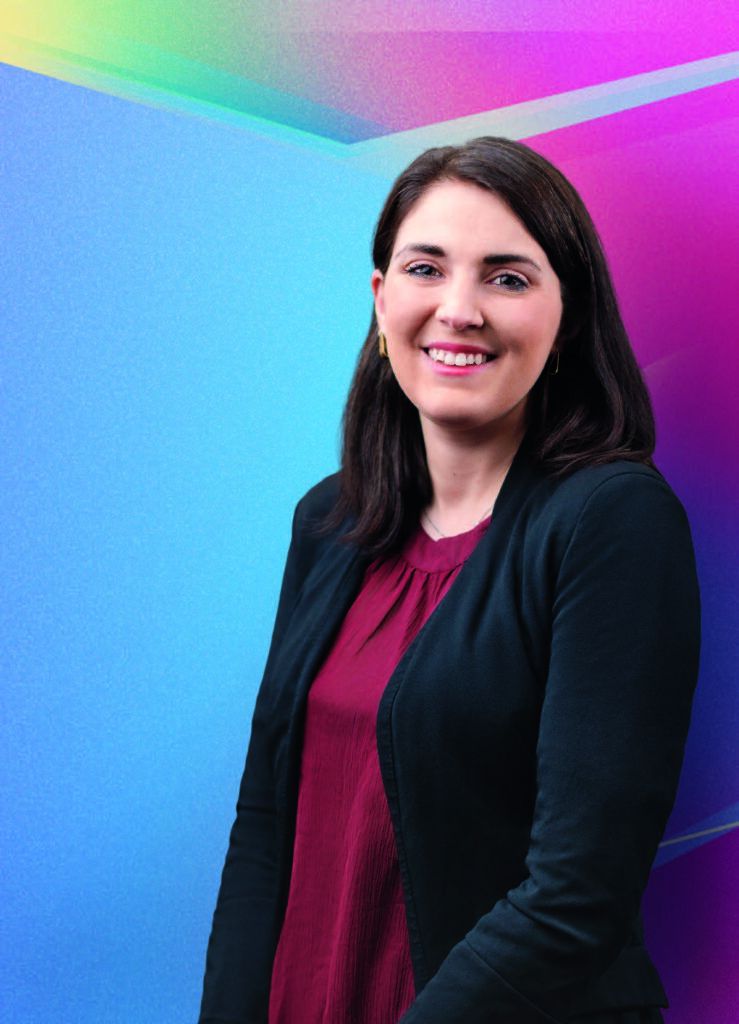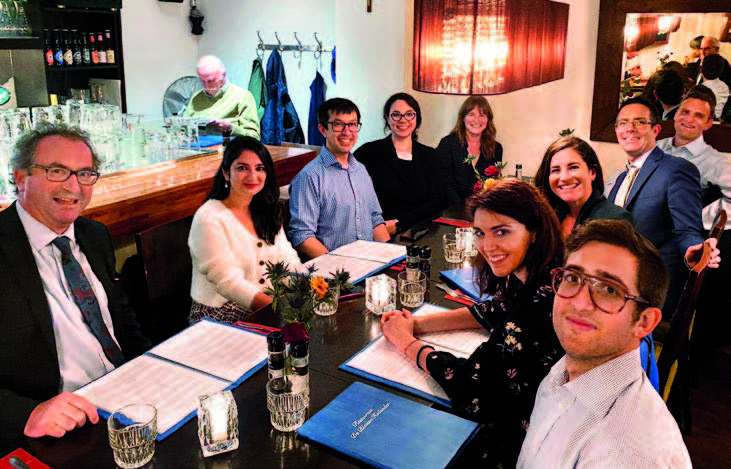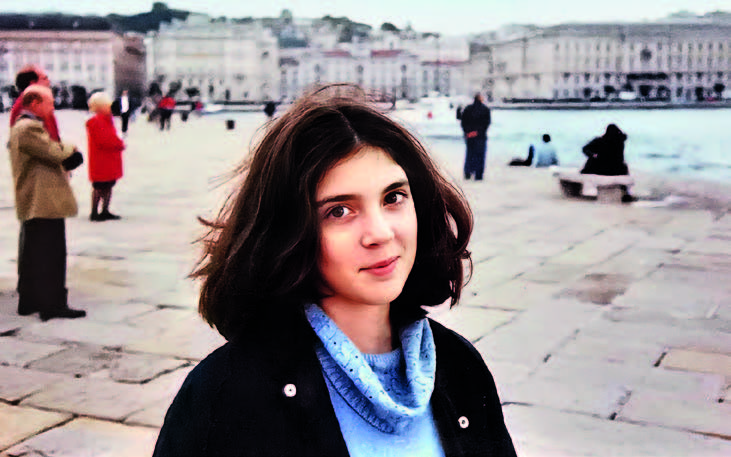MORE TO EXPLORE: Laura Cacciaguerra, M.D., Ph.D., isn’t afraid to venture into the unknown
Meet the 2025 recipient of the Mayo Clinic Alumni Association Edward C. Kendall Award for Meritorious Research

Laura Cacciaguerra, M.D., Ph.D.
Research fellow in autoimmune neurology
Mayo Clinic in Minnesota
Postgraduate: Ph.D., molecular medicine, Vita-Salute San Raffaele University, Milan, Italy
Residency: Neurology, Vita-Salute San Raffaele University, Milan, Italy
Medical school: University of Padova, Padova, Italy
Hometown: Trieste, Italy
If Laura Cacciaguerra, M.D., Ph.D. (N ’22), had been born a few hundred years ago, she would likely be the one boarding the ship or hacking through the jungle to explore places beyond the map.
As a scientist of the modern age, she instead found herself drawn to neurology.
“There is so much that is unknown, and I like that part,” she says. “There’s a lot to discover.”
This is especially true in her area of study: the rapidly evolving field of demyelinating disorders. In her research, she’s not afraid of unexpected results that don’t match her hypotheses — they just signal that there’s more to explore.
“There is so little known in this field that you cannot take (any information) for granted,” she says. “Even if prior literature had a different hypothesis, I take that into consideration, but it doesn’t bother me if I see something different. I think that’s the exciting part: when you see something you didn’t expect.”
This willingness to venture into new scientific territory has paid off, leading her to become an interna- tionally recognized expert in the imaging of two recently recognized central nervous system demyelinating diseases that mimic multiple sclerosis (MS): myelin oligodendrocyte glyco- protein antibody-associated disease (MOGAD) and neuromyelitis optica spectrum disorder (NMOSD).
“Dr. Cacciaguerra pursues research not based on external assignments, but on her own obser- vations and ideas,” says her research mentor, Eoin Flanagan, M.B., B.Ch. (I1 ’09, N ’12, NMS ’13, NAI ’14, NBN ’15, CTSA ’16), chair, Division of Multiple Sclerosis and Autoimmune Neurology, Mayo Clinic in Minnesota. “Rather than relying on following prior lines of research, she believes in a systematic approach aimed to reconstruct each disease’s unique pathophysiology based on its unique features and differences from (other diseases).”
Today, Dr. Cacciaguerra is a research fellow in autoimmune neurology at Mayo Clinic in Minnesota and is affiliated with Mayo Clinic’s Center for Multiple Sclerosis and Autoimmune Neurology. She is the 2025 recipient of the Mayo Clinic Alumni Association Edward C. Kendall Award for Meritorious Research.
“Dr. Cacciaguerra’s contributions to our understanding of epidemiology, imaging and immunopathology of MOGAD and autoimmune neurological disorders of the central nervous system are not only significant but also transformative,” says research mentor Sean Pittock, M.D. (N ’02, I1 ’03, NMS ’04), the Glenn W. and Katherine K. Hasse Chair of Neurology at Mayo Clinic in Minnesota. Dr. Pittock is also the Applebaum Family Professor of Neurosciences and the Marilyn A. Park and Moon S. Park, M.D., Director of the Center for Multiple Sclerosis and Autoimmune Neurology.
THE BEST PLACE TO BE
When Dr. Cacciaguerra realized she wanted to study demyleinating disorders, she knew Mayo Clinic was the best place to be.
For one thing, a team of Mayo Clinic researchers led by Vanda Lennon, M.D., Ph.D. (LABM & PATH ’78), a consultant in the Division of Clinical Biochemistry and Immunology at Mayo Clinic in Minnesota and the Dorothy A. Adair Professor, discovered the pathogenic AQP4-IgG autoantibody that causes and is a biomarker for NMOSD.
“That discovery definitely changed the history of demyelinating disorders,” Dr. Cacciaguerra says. “Now they have found an extremely effective treatment which is tailored to the pathophysiology. It’s one of the few examples of autoimmune neuro- logical disorders where you know exactly what is going on and how to treat it.”
Dr. Cacciaguerra came to Mayo Clinic in 2021 as a visiting research fellow and quickly became a prolific member of the Mayo Clinic team. She’s now a permanent research fellow and has produced 39 peer- reviewed articles currently published or in press since arriving at Mayo, including multiple first-authored articles in top-tier, high-impact neurology journals such as Neurology, Annals of Neurology and Multiple Sclerosis Journal. Her work has already garnered over 1,000 citations. She has given platform and poster presentations at national and international conferences and meetings, including the annual meetings of the American Academy of Neurology (AAN) and of the European Committee for Treatment and Research in Multiple Sclerosis (ECTRIMS).
Throughout her time, she has been impressed by Mayo Clinic’s patient-centric focus.
“Sometimes we are talking about rare disorders, but the numbers don’t really matter. At Mayo, they believe every single patient counts,” she says.

Laura Cacciaguerra, M.D., Ph.D., dining with colleagues in Amsterdam at the 2022 European Committee for Treatment and Research in Multiple Sclerosis (ECTRIMS) meeting. Her research mentor Sean Pittock, M.D., sits on the far left, and her research mentor Eoin Flanagan, M.B., B.Ch., appears second from the right.

A childhood photo of Laura Cacciaguerra, M.D., Ph.D., in her hometown of Trieste, Italy
IMPACTING CLINICAL CARE THROUGH RESEARCH
Though early in her career, Dr. Cacciaguerra already has a long list of significant research findings.
At Vita-Salute San Raffaele University, she proposed a clinically feasible MRI-based algorithm to discriminate between MS and NMOSD. The MRI features she identified were externally validated in two separate cohorts and are now known internationally as “Cacciaguerra criteria.”
In addition, Dr. Cacciaguerra’s work helped illuminate the complex MRI correlates of NMOSD pathophysiology, a disease that targets aquaporin-4 (AQP4), the protein that regulates brain water homeostasis. She used a new proxy technique for measuring brain water content in NMOSD and found that water content increased in direct relation to disease activity. This has implications for clinical practice, given that there are no recognized radio- logical biomarkers of early disease activity in NMOSD. The work earned her the Investigation Award at the 2021 European Academy of Neurology meeting.
She has since further delved into NMOSD pathophysiology, attempting to reconstruct the biological pathways of the disease starting from its MRI findings. Her work merges the distribution of brain damage with spatial transcriptomic data, which contains information on how thousands of genes are actively expressed in specific locations.
At Mayo Clinic, Dr. Cacciaguerra has focused on MOGAD, which was officially recognized as a separate entity with published diagnostic criteria in 2023. However, instead of developing new methodologies and looking for specific biomarkers of MOGAD, much of the research translated the clinical and scientific assumptions established in MS to MOGAD, Dr. Cacciaguerra says.
But Dr. Cacciaguerra found that unlike other demyelinating diseases, MOGAD acute lesions often resolve completely, at times quickly and without treatment, as part of the disease’s natural history. In a first-author paper, she found that 10% of symptomatic MOGAD patients present with initially normal, lesion-free MRIs. Like MS patients, MOGAD patients often undergo MRI scans during disease remission, but she demonstrated acute scans are more informative.
These findings are “already shifting the current radiological surveillance paradigm in this disease,” Dr. Flanagan says. Dr. Cacciaguerra’s paper on the subject was published in Neurology with a positive editor’s note. The study is one of her proudest accomplishments, as it came with an important clinical message not to disqualify MOGAD in the case of a normal MRI, she says.
She is also the first author of the first MOGAD epidemiology study from the U.S., and she has made significant findings related to MS imaging. Current MRI spinal cord imaging guidelines for MS say that sagittal images are sufficient and axial images are optional. But Dr. Cacciaguerra’s study — presented at the 2023 ECTRIMS annual meeting to great acclaim — showed that axial spinal cord MRI images in MS detect twice as many lesions as sagittal images.
“These practice-changing findings will allow earlier MS diagnosis, help guide treatment decisions and improve prognostication in MS, and lead to a changing of these guidelines,” Dr. Flanagan says. “Her study will likely impact the lives of many MS patients.”
Dr. Cacciaguerra is grateful for all the support she has received along the way.
“I would like to thank my mentors Dr. Flanagan and Dr. Pittock for the support, guidance and opportunities given to me through these years at Mayo Clinic and for showing me every day what it means to be passionate about research and patients’ care,” says Dr. Cacciaguerra. “A special thanks also to Maria Assunta Rocca, M.D., and Massimo Filippi, M.D., from my time in Milan, who first introduced me to neuroimaging and still help me even from a distance.”
“THERE’S A LOT OF HOPE”
Looking forward, Dr. Cacciaguerra wants to study whether the disap- pearance of lesions in MOGAD — which points to possible remyelination — can be translated to other disorders. She’d also like to use novel tools like artificial intelligence (AI), proteomics and transcriptomic atlases of the brain, and she’s taking Harvard University courses to expand her AI and computer science knowledge.
By using a similar approach to her work researching NMOSD pathophysiology, she wants to use atlases in combination with the distribution of MOGAD lesions to uncover more about remyelination.
“Understanding the underpinnings of greater remyelination in MOGAD could be a first step towards the holy grail of targeting remyelination in MS,” Dr. Flanagan says.
The possibility of contributing to a discovery with a potentially huge impact on patient wellness is just another example of what motivates her to work in this ever-evolving field.
“There’s a lot of hope when you see things changing so quickly,” she says.
Read about the 2025 Balfour Awardee here.
Illustration by Ameesha Lee.